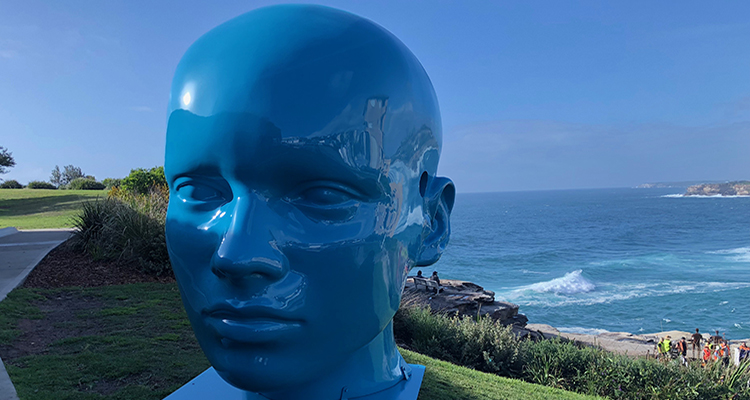
What could you see if you have post-traumatic stress disorder? UNSW’s Sculpture by the Sea offers a unique audio-visual experience of PTSD.
UNSW’s Sculpture by the Sea interactive installation, “Look Inside My Mind”, towers at two-and-a-half metres tall. Situated at the top of the steps at Marks Park in Tamarama, the sculpture is a large blue head with three viewing windows, offering a glimpse into anxiety experienced by those who have post-traumatic stress disorder (PTSD).
Over three suspenseful minutes, a video reflects the Bondi landscape with internal speakers echoing the ocean and other sensory sounds. Suddenly, the video distorts and the scene begins to intensify. The sculpture vibrates with growing pulses and breathing and the inanimate objects along the coastal walk come to life, jumping out before quickly disappearing. Flashbacks of military conflict appear, and reality blurs as the scene becomes more chaotic. As it reaches a crescendo, images of water and bubbles surround the view as the scene calms. The restorative view of the ocean brings reality back into focus as the experience comes to an end.
The audio-visual experience inside the sculpture, submitted to Sculpture by the Sea by UNSW TV’s Matthew Gill, is the culmination of the stories and symptoms of five men and three women interviewed for the project; servicemen and women who shared their experiences of post-traumatic stress syndrome.
Matthew led the team behind the build of the head, androgynous and ageless in character, and was passionate about getting both the sculpture and the video right while dealing with such a sensitive issue.
“It’s about a conversation – we wanted to get people talking about this issue,” he said. “We spoke to a number of people with PTSD. A couple were happy to speak publicly about the project, but there were several who weren’t comfortable. The detail and research behind a project deals with such a sensitive issue, we respected the wishes of everyone we interviewed. The final video that appears inside the head is a collective view of what might go on during a period of anxiety.”
A collaborative effort
The project was a collaborative effort. UNSW Canberra found people with PTSD and helped to provide military footage for the video. The UNSW TV team and the Division of External Relations were involved with the production and execution of the art. UNSW Medicine’s team underpinned the research.
This collaborative effort has resulted in art which leverages our research strength. UNSW Medicine is passionate about research into mental health, with ‘Neuroscience, Mental Health & Addiction’ one of the main research themes of the Faculty and its collaborative networks.
Professor Zachary Steel, St John of God Chair of Trauma and Mental Health, Richmond Hospital, UNSW Medicine and expert in the field of PTSD, explains why the sculpture’s message is so powerful. “We hear about post-traumatic stress disorder all the time in the media, but there is very little understanding of what it’s like to actually live with it. Perceptual and cognitive impairments create a huge impact on individuals trying to live normal lives post trauma. The disorder often puts them in a chronic state of arousal.”
While focussed on the effects of PTSD, the sculpture also epitomises Mental Health Month’s theme: ‘Do you see what I see?’ UNSW Medicine has used the sculpture to bring attention to mental health throughout the month by partnering with the Wellbeing team and UNSW Fitness & Aquatic Centre to support a wide array of activities on campus to recognise mental health and wellbeing.
“Not only is it an opportunity to celebrate art, but we can use this to have a conversation among ourselves: To challenge our own thinking, to allow us a moment to ask, “Are you ok?” explained Jonathan Pheasant, UNSW Medicine’s Faculty Executive Director.
UNSW Medicine is hosting a number of activities in conjunction with the Sculpture by the Sea exhibition, including yoga at Tamarama, artist and research talks, and bus tours for UNSW staff. To see a full list of events and to RSVP, visit here.
Sculpture by the Sea runs October 18 – November 4.
- Log in to post comments
